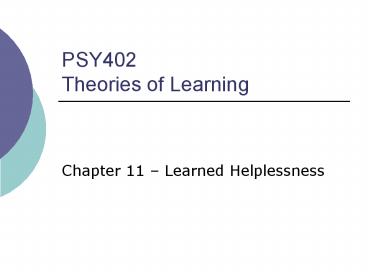PSY402 Theories of Learning - PowerPoint PPT Presentation
1 / 20
Title:
PSY402 Theories of Learning
Description:
PSY402 Theories of Learning Chapter 11 Learned Helplessness Learned Helplessness Theory Seligman depression is learned. Depression occurs when people believe ... – PowerPoint PPT presentation
Number of Views:203
Avg rating:3.0/5.0
Title: PSY402 Theories of Learning
1
PSY402Theories of Learning
- Chapter 11 Learned Helplessness
2
Learned Helplessness Theory
- Seligman depression is learned.
- Depression occurs when people believe
- Failures are due to uncontrollable events.
- Failure will continue as long as events are
beyond their control. - Depression arises from helplessness.
3
Animal Research
- Step 1 -- three groups of dogs
- Inescapable shock no control.
- Escapable shock -- terminated if the dog pressed
a panel. - No shock
- Step 2 10 trials of signaled avoidance training
in shuttle box. - 2/3 of inescapable shock dogs did not learn to
jump during step 2.
4
Helplessness in Humans
- Hiroto three groups of college students
- Uncontrollable group wrongly told that pushing
button would end noise. - Escapable group pushing button ended noise.
- Control no noise.
- Tested using finger shuttle box.
- Uncontrollable group did not escape
5
Characteristics of Helplessness
- Motivational impairment unable to initiate
voluntary behavior. - Mice in water maze.
- Nonspecific carries over to a variety tasks and
test situations. - Intellectual impairment incapable of benefiting
from future experience even if they jump, dont
learn. - Emotional trauma neg. affect.
6
Studies of Depressives
- Show similar results to learned helplessness
studies. - Depressed individuals do not escape noise,
responding like inescapable non-depressed
individuals. - Depressed individuals do not adjust likelihood of
succeeding upward when they experience success. - They credit chance not skill.
7
Criticisms of Seligmans Theory
- There is more to depression than learned
helplessness. - Helplessness subjects described the task as a
skill task, even though acting as if it were a
chance task. - Failure to replicate performance deficits in
humans facilitation of performance instead. - May be due to attributions.
8
Attribution Theory
- Causal attributions of failure have three
dimensions - Internal-external internal traits or
characteristics vs environmental forces - Stable-unstable past causes will persist vs new
forces will determine future outcomes - Global-specific outcome relates only to one
task vs outcome effects everything.
9
Attributional Model of Depression
10
Two Kinds of Helplessness
- Personal helplessness an individuals inability
causes failure. - Universal helplessness the environment is
structured so that no one can control future
events. - Abramson -- both kinds lead to depression.
- Vary on external-internal dimension.
- Low self-esteem only with personal.
11
Severity of Depression
- Depression can be transient if attributed to
global but changing conditions. - Severe depression occurs when attributions are
- Internal
- Global
- Stable
- Better if external, specific, unstable.
12
Hopelessness Depression
- Hopelessness the expectation that desired
outcomes will not occur. - Learned helplessness -- no control over undesired
outcomes. - Accounts for anxiety without depression.
- Anxiety possibility that a person may have no
control over negative events. - Depression occurs when certain.
13
Pessimism
- Pessimistic explanatory style attributional
style predicts susceptibility to depression. - Langer a perceived control is basic to human
functioning. - Optimists feel they can control events, more
successful. - Pessimists believe they have no control over
events.
14
Cognitive View of Phobia
- Bandura two kinds of expectancy maintain a
phobia - Stimulus-outcome expectancy about the nature of
the stimulus. - Response-outcome expectancy about the likely
result of behavior. - Why does phobia produce behavior with negative
outcomes? - Efficacy expectancy belief that one cannot
execute a particular action.
15
Self-Efficacy
- Types of information used to establish
self-efficacy - Personal accomplishments, success.
- Task difficulty, amount of effort.
- Observations of success/failure of others
vicarious modeling. - Emotional arousal we feel less able to cope
when agitated or tense. - Efficacy predicts approach behavior.
16
Criticisms of Efficacy View
- Efficacy expectations may be epiphenomenal
arise with anxiety but do not affect responding. - Three types of anxiety
- Cognitive affects self-efficacy
- Physiological affects physiology
- Behavioral affects responding.
- Lang contribution of each depends on prior
experience and situation.
17
Contemporary Theories
- Shift from global theories to theories about
specific aspects of learning. - Global theories were about operant responding not
classical conditioning. - An animals biology influences whether, what, and
how fast it can learn. - Cognitive view requires emphasis on specific
cognitive processes.
18
Stimulus-Substitution Theory
- What is the nature of the CR is it just the UCR
of is it different? - Pavlov stimulus-substititon theory
- The CS stimulates the same areas of the brain as
the UCS, producing the same response. - Activation of CS with UCS establishes neural
connection between brain areas.
19
Conditioned Opponent Response
- The CR and UCR are often different
- CR of fear is different than UCR of pain.
- Siegel best evidence of difference
- Morphine (UCS) produced analgesia, reduced pain
(UCR) - Light or tone (CS) produced hyperalgesia,
increased pain (CR). - Rats remove paws from heat quickly with CS,
slowly with UCS. - Insulin (glycemia) works the same way
20
Conditioning and Drug Tolerance
- Elimination of a CS results in a stronger
response to the UCS, drug. - Extinction of responding to environ-mental cues
strengthens drug response - Changing the context in which a drug is
administered increases response to the drug. - Novel environment does not elicit an opponent CR.































